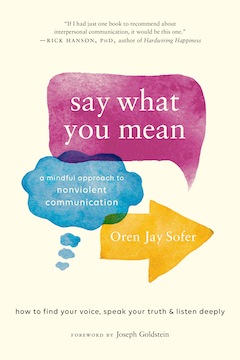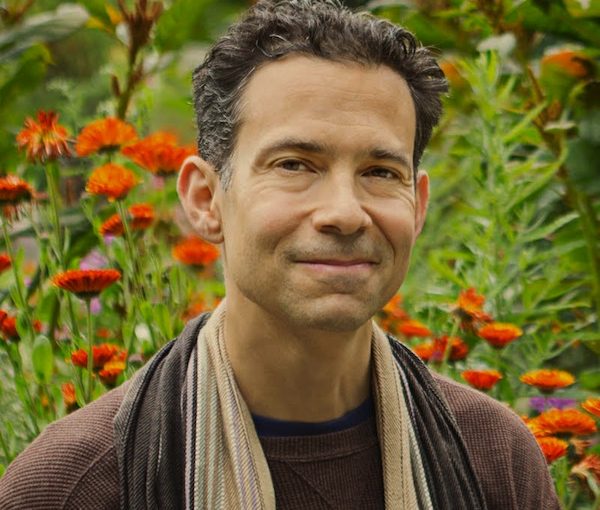Oren Jay Sofer believes that, with nonviolent communication, a person can learn “how to identify what is most important to you and what’s more important to someone else … and, then, how to come up with more solutions and ideas for complex situations.” (photo from Oren Jay Sofer)
Oren Jay Sofer, author of Say What You Mean: A Mindful Approach to Nonviolent Communication, took a longer route to finding his connection to Judaism. “Probably,” he said, “most of it was because the teachings weren’t really available for me growing up – the more mystical or spiritual teachings of Judaism.”
The Buddhist practice of meditation resonated with Sofer. Then, he happened upon Dr. Marshall Rosenberg’s practice of nonviolent communication. Through learning about it, Sofer gained an accessible and practical complement to the inner transformation of meditation. “The two really started to work together in a synergistic fashion – in my personal transformation, in my relationships and in my direction in life,” said Sofer. “That, over time, led me to the work I’m doing today.”
A couple of years ago, Sofer was approached by a publisher about writing a book on his practices. He jumped at the opportunity to share what he had learned from integrating meditation practice, nonviolent communication and other concepts through Dr. Peter Levine’s work of somatic experiencing, a way of healing trauma through the nervous system.
“I was getting feedback [from students] that there was something unique about bringing these systems together, that people found really helpful,” said Sofer. “So, I wanted to reach more people, to write it down in a way that other people can go through this sort of progress of learning that I’ve put together – that could be of great benefit to them personally and for our society, in terms of the kinds of divisiveness and polarization people are experiencing around the world in so many places.
“I wanted to reach more people and help them have the tools to have more meaningful conversations in their life,” he added.
Sofer has found that communication and mindfulness are effective vehicles for aligning one’s life with one’s values, insofar as the choices we make, the work we do and the conversations and relationships we have.
This way of communication is accessible to anyone, no matter what age, religious belief, race, gender, or otherwise. “It’s for anyone who wants to improve their communication and have better conversations – parents, employees, supervisors, spiritual seekers, students, anyone – that is something I find so powerful and gratifying about this work, that it unites us as human beings,” said Sofer.
“We all communicate. And, we do it pretty much all day long in every area of our life. Even when we are alone, we have that inner voice going. So, the audience isn’t limited in any way, because we all depend on communication in our lives and it’s one of the things that determines our happiness. I really see this as a life skill that’s important for everyone.”
According to recent research conducted by Shawn Achor and others, the social relationships and connections we foster are one of the greatest predictors of long-term happiness, as well as of many different health markers. And, the quality of our relationships, to a large degree, is determined by our communication skills.
 The book is set up rather like a field guide of how to communicate and converse. So, it’s not the kind of book you will read over one weekend or week. It is one you can read over several months, taking a few pages at a time, with exercises and principles interspersed throughout to work on and absorb.
The book is set up rather like a field guide of how to communicate and converse. So, it’s not the kind of book you will read over one weekend or week. It is one you can read over several months, taking a few pages at a time, with exercises and principles interspersed throughout to work on and absorb.
“You can’t learn to swim by reading a swimming manual, right?” said Sofer. “You need to get into the water. You can’t learn to communicate from a book. You have to do it. But, the book can tell you how to do it in a way that you’re running experiments that will give you the information you need to figure out what will work best in your life and relationships. It’s really meant to be applied in a step-by-step way. And, it takes people through a whole arc of training with specific foundations to integrate into their lives.”
The book’s first foundation is to “Lead with Presence,” which Sofer views as an essential prerequisite for any effective conversation or meaningful relationship.
“We need to be here to have more self-awareness if we’re going to navigate the complex terrain of human interaction with any skill or clarity,” said Sofer. “So, there’s a whole section about what it means to have more self-awareness, how to cultivate it and how to bring it into our relationships and conversations.
“And, there are all kinds of practices, skills and pointers – everything from pausing, to developing more embodied self-awareness, to developing what I call ‘relational awareness,’ which is the capacity to be not just aware of yourself, but of the other person, space and energy between you.
“Then, the book looks at our intentions, which is a huge component of human interaction, happening beneath the words. Our non-verbal communication is, to a large degree, shaped by our intentions.”
With the goals of building the kind of goodwill, trust and collaboration that lead to more satisfying connections, Sofer guides the reader through a self-reflection about their habits, training, family, culture and society, to help them determine which parts need improvement.
“There are many different stories I tell about the power of intention in conversation,” he said. “The third section really looks at how we navigate conversations themselves – in terms of where we place our intentions, how we say what we really mean, how we know what we mean, how we come to more clarity about ourselves about what’s happening, and how we hear others more clearly, even when they’re speaking to us in ways that are critical.
“This section is really where the training in nonviolent communication comes in, looking at the mechanics of the conversation, how to become more skilful, how to identify what is most important to you and what’s more important to someone else … and, then, how to come up with more solutions and ideas for complex situations.”
According to Sofer, one of the roots of violence stems from our relationship to emotional and psychological pain, and the views and beliefs we hold about their origins.
“If I believe that you caused my pain, then there is a very short distance to the assumption that you deserve to be punished or to have retribution, being the cause of my pain,” said Sofer. “In nonviolent communication, we differentiate between the cause and the stimulus. Obviously, we affect one another in this world. We stimulate pain, but we don’t directly cause it. This is a very radical concept in many ways for people to take in.
“When we examine it, we start to see the truth of it, which begs the question if anyone can actually make you feel some way. And, you know, two different people will respond to the same event completely differently. One person will respond completely differently on two different days.
“So, the nonviolent component, in one way, is pointing to this link between our language and our willingness to use physical violence to accomplish our aims or meet our needs. When we think and speak in ways that are connected to our shared humanity, one of the aims of nonviolent communication is that violence no longer makes sense, as we’re in touch with a deeper layer of our existence.”
Sofer also speaks about the origins of nonviolent communication as a tool to create social change, noting “Without transforming our outlook, interactions and consciousness, it’s impossible to transform our society for the better.”
Sofer’s book, Say What You Mean: A Mindful Approach to Nonviolent Communication, is sold by many vendors, but there is a free gift offer when it is purchased from the author’s page, orenjaysofer.com/book.
Rebeca Kuropatwa is a Winnipeg freelance writer.

